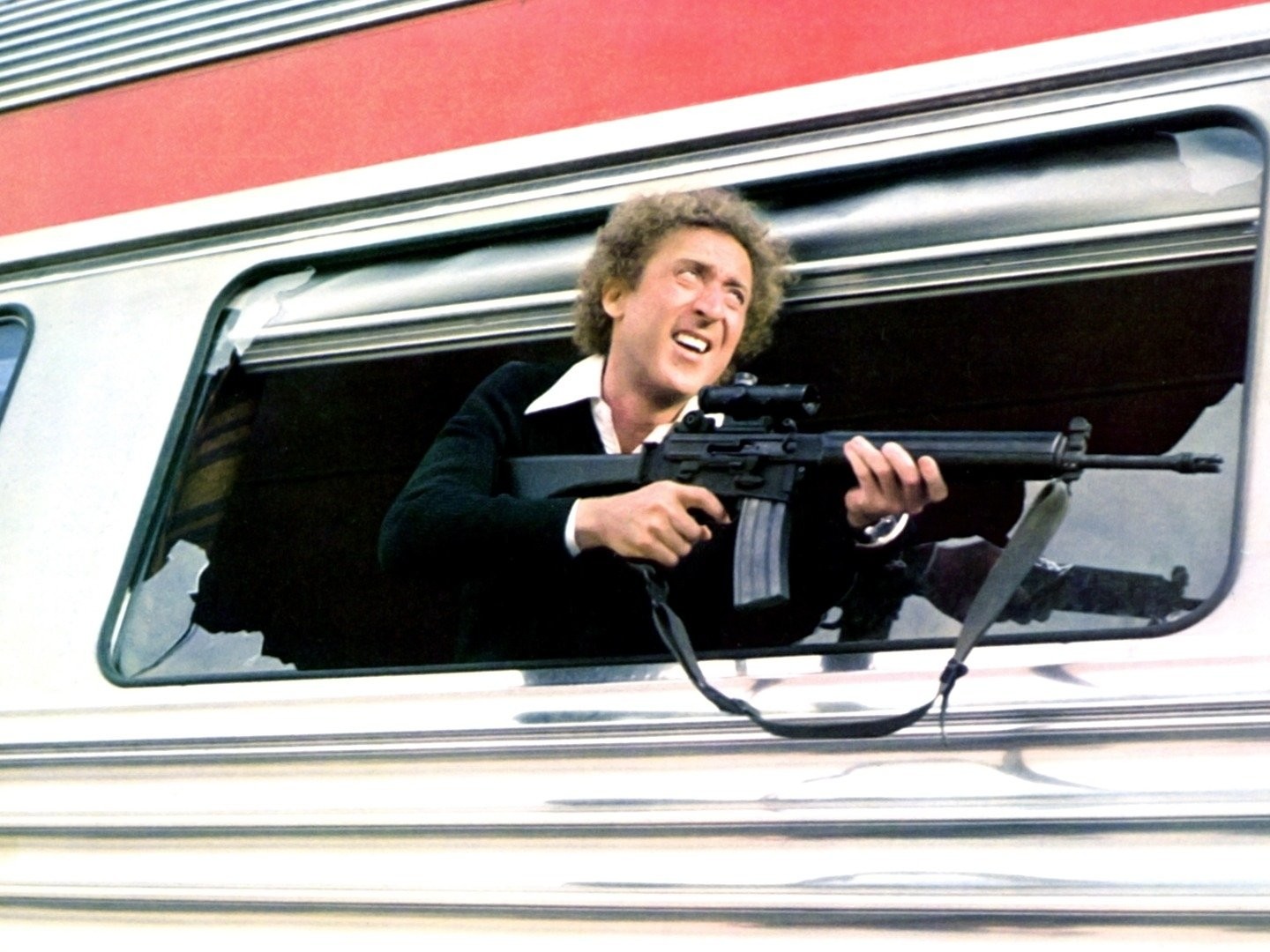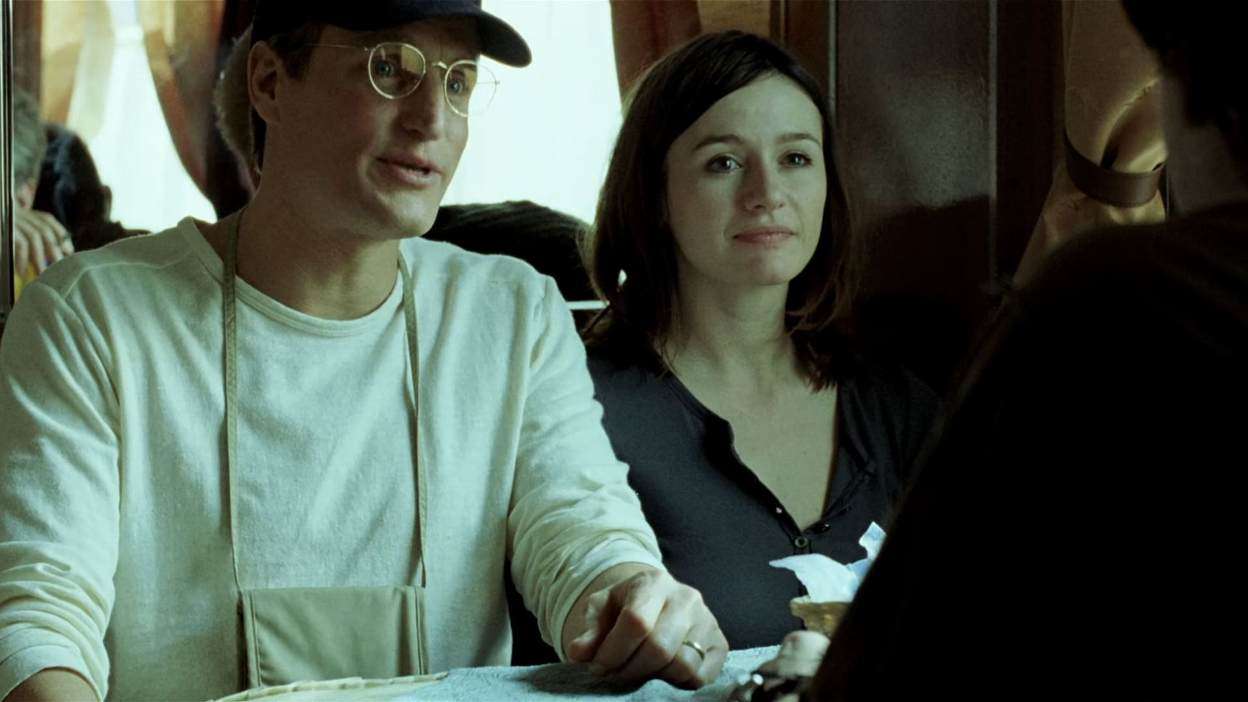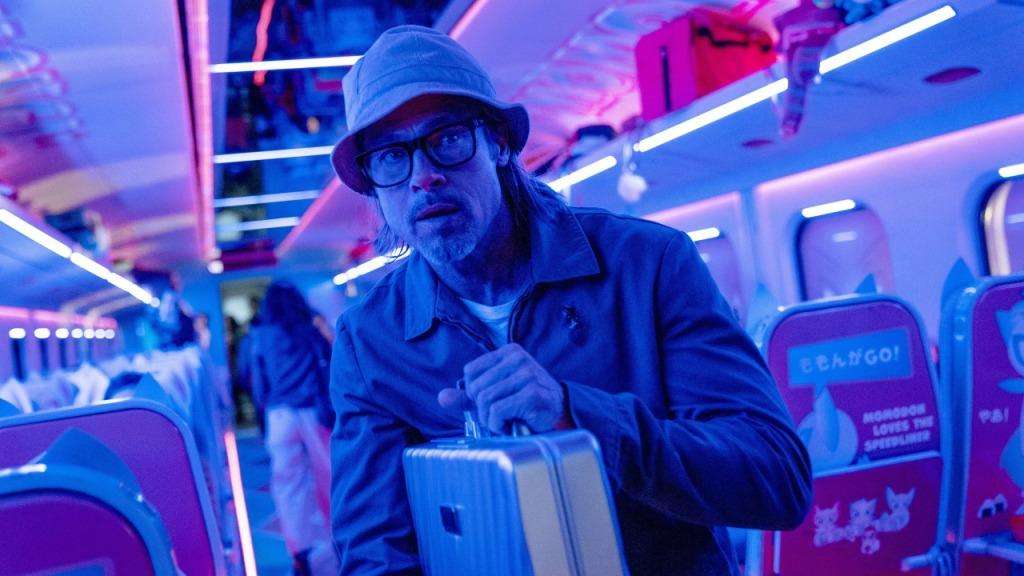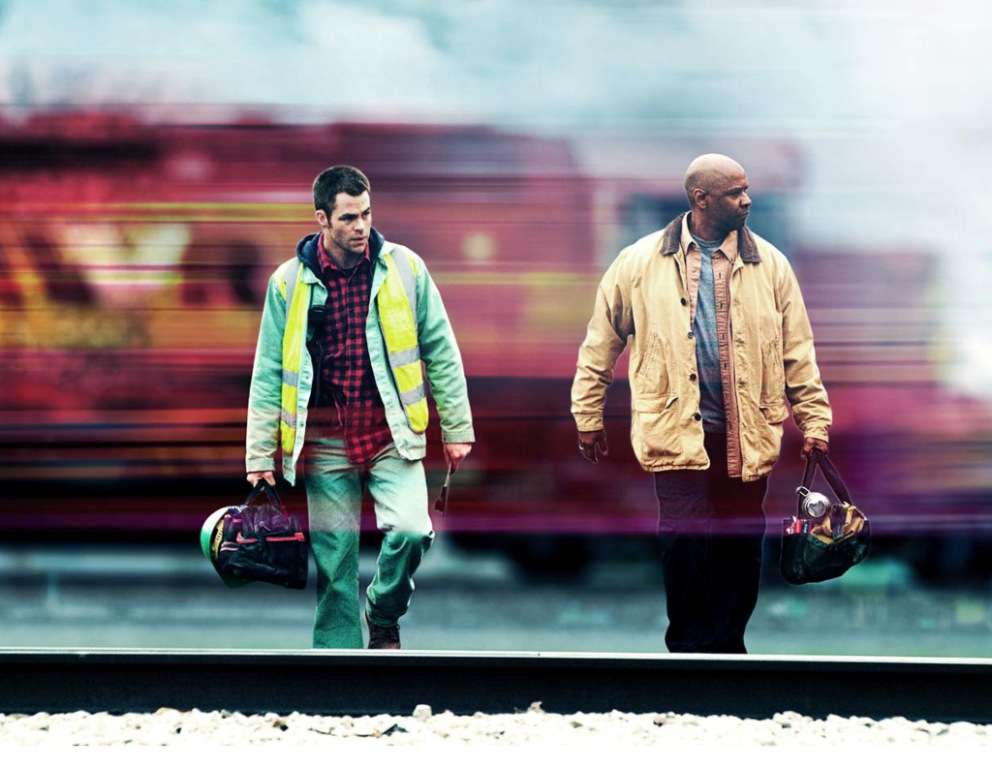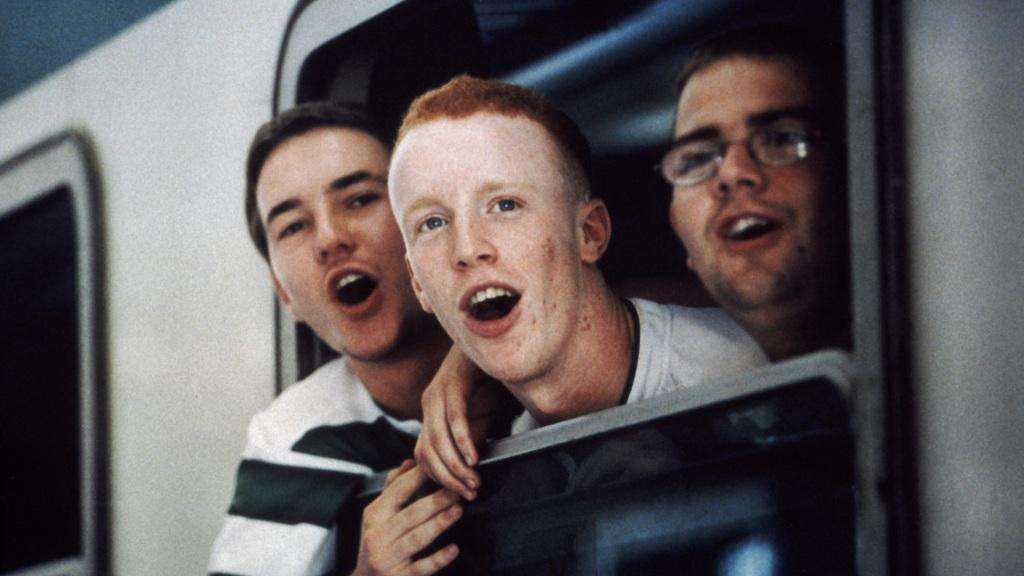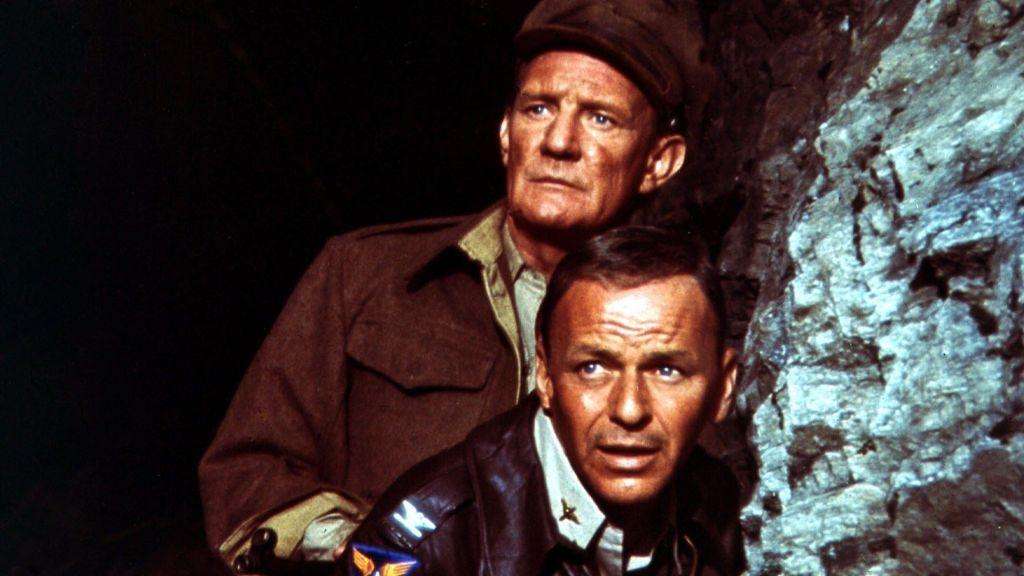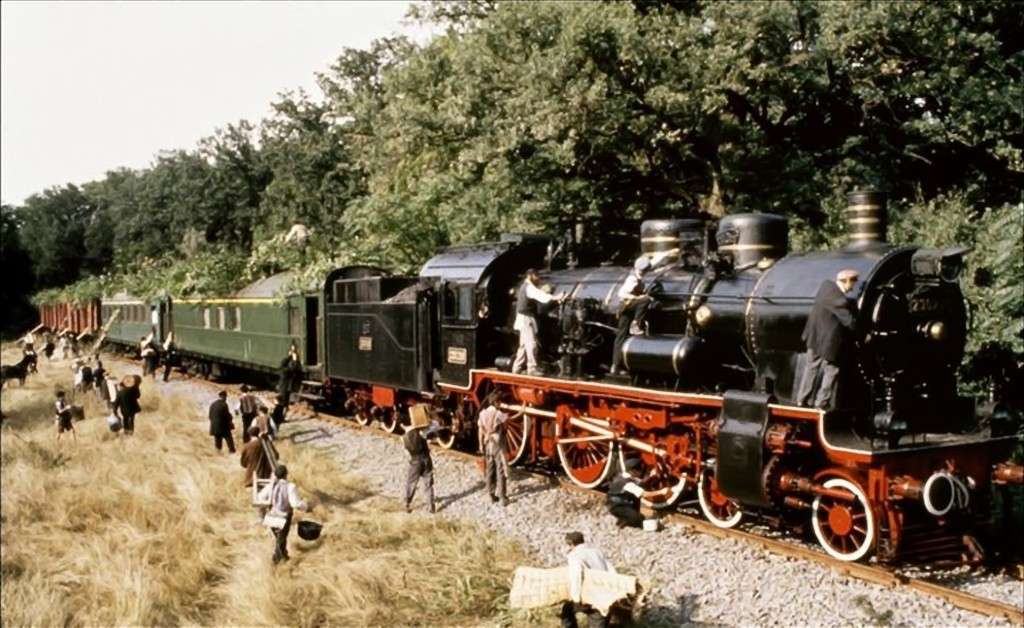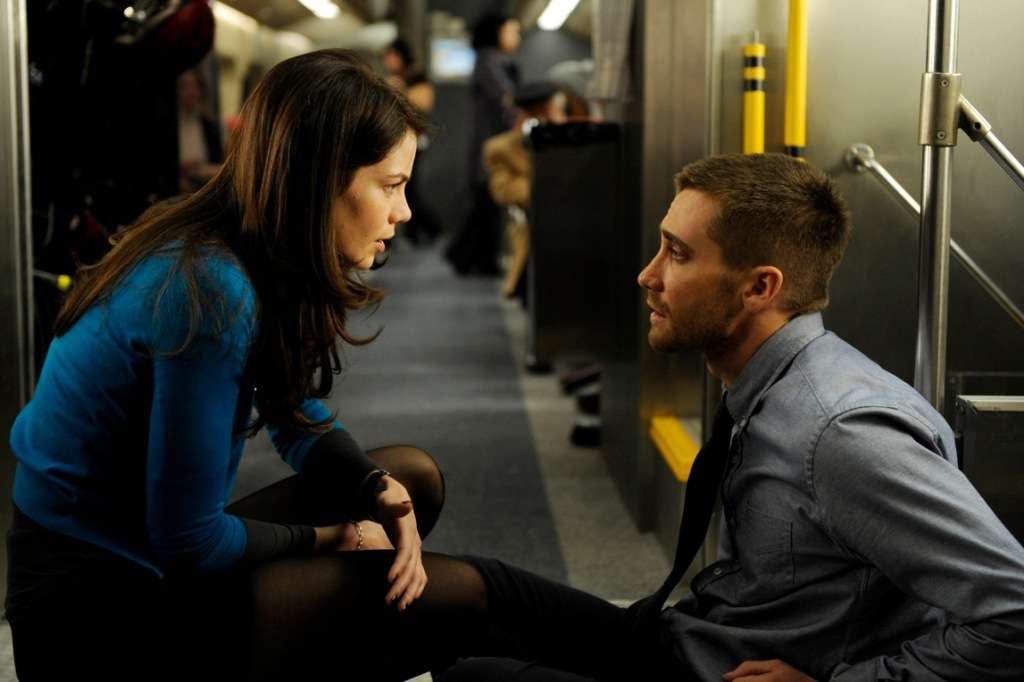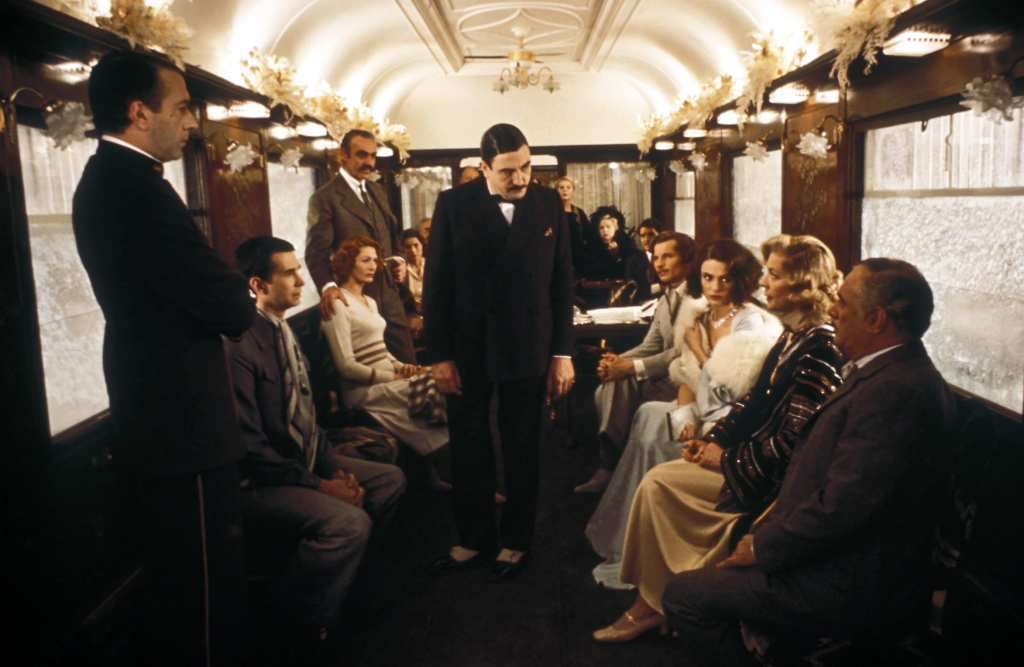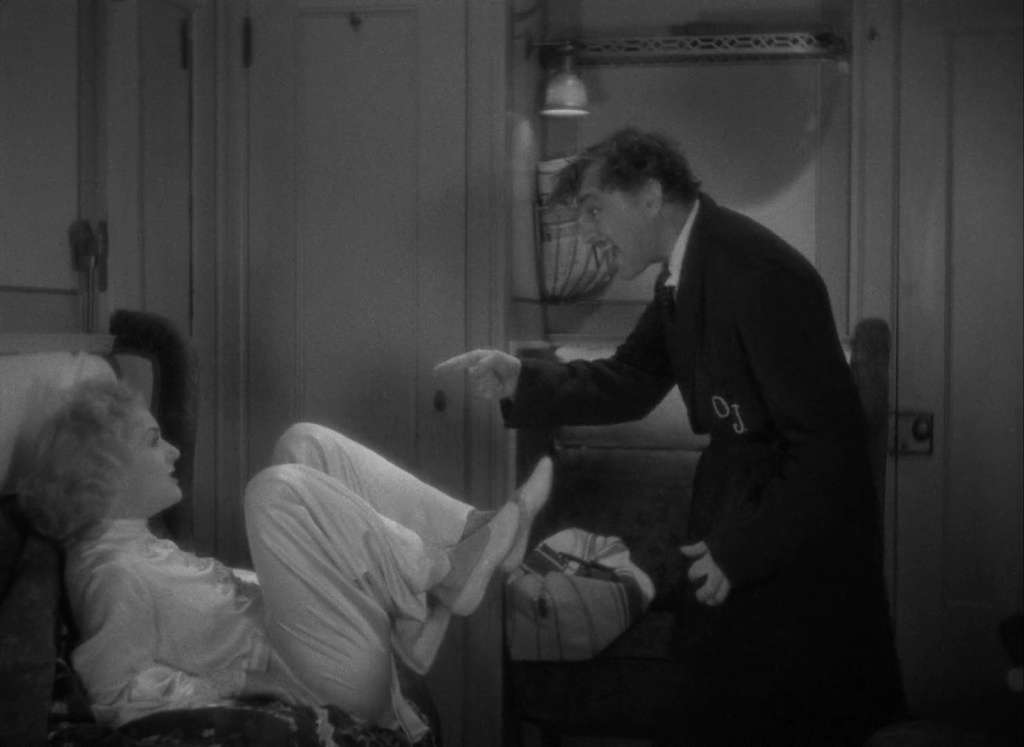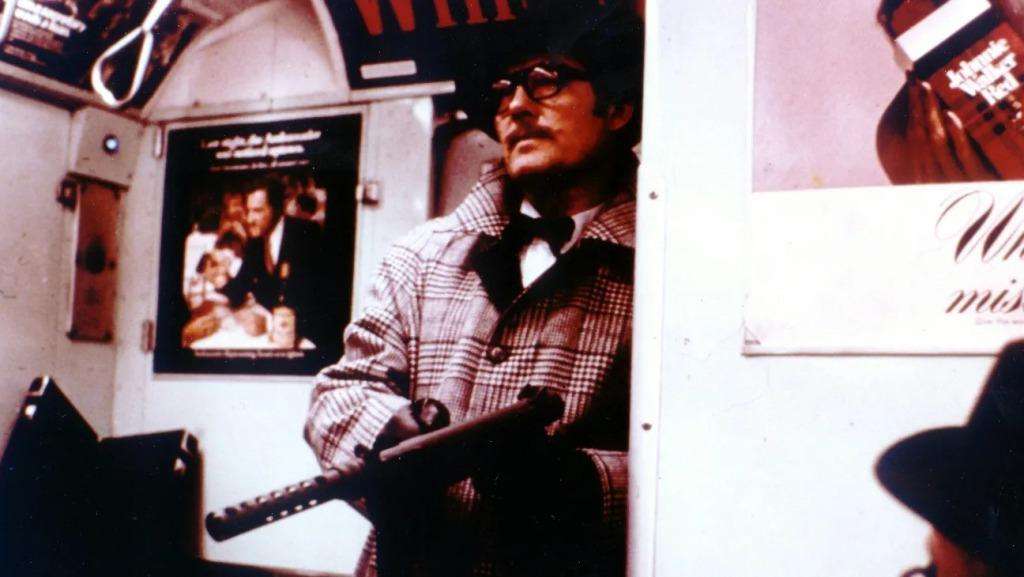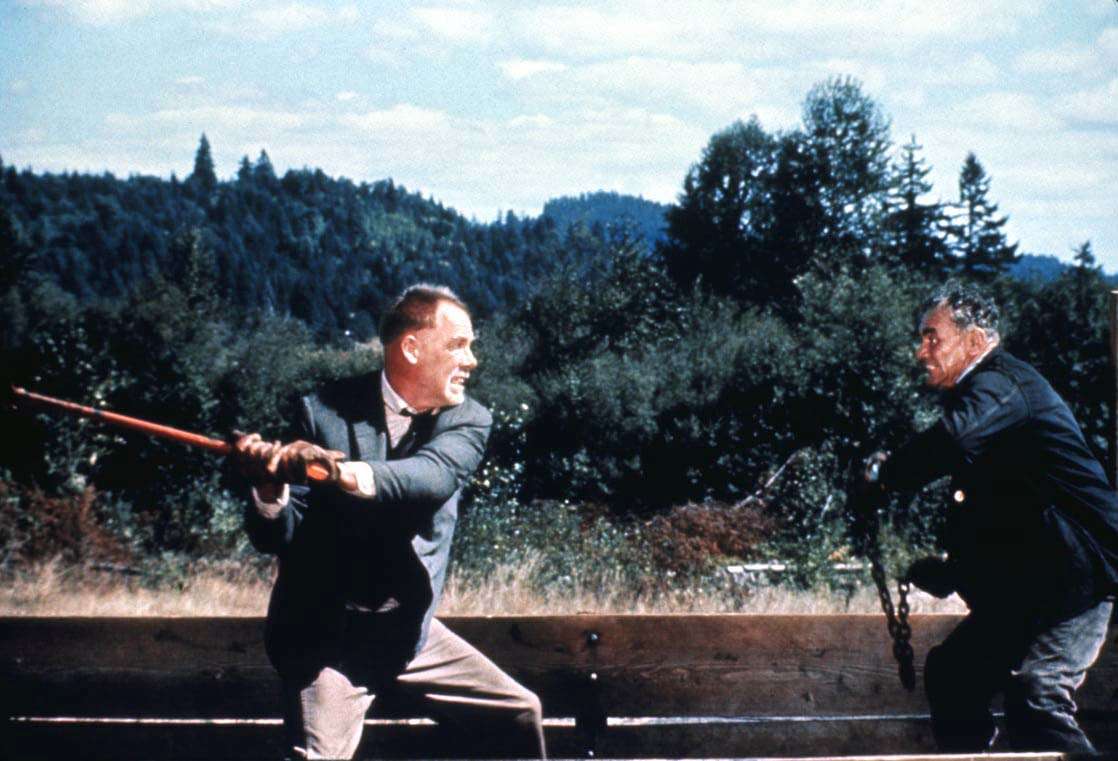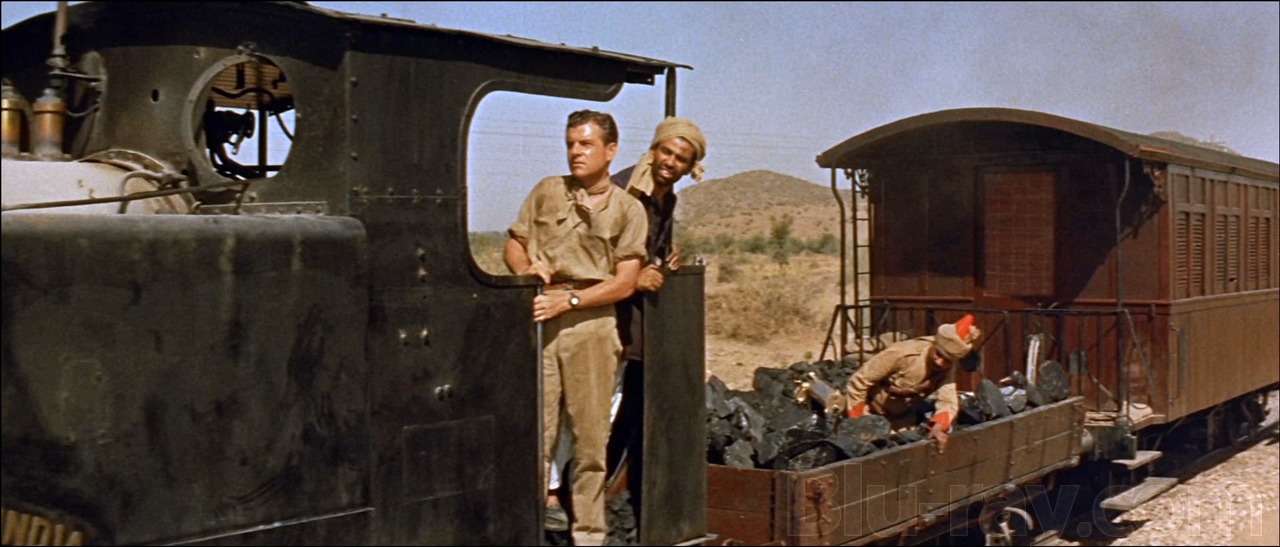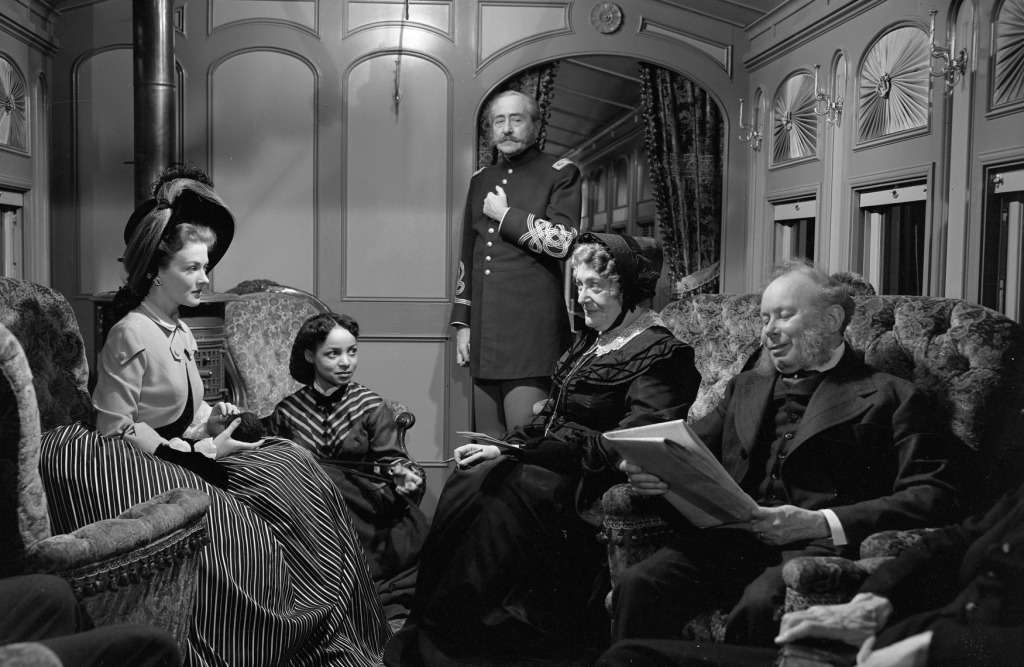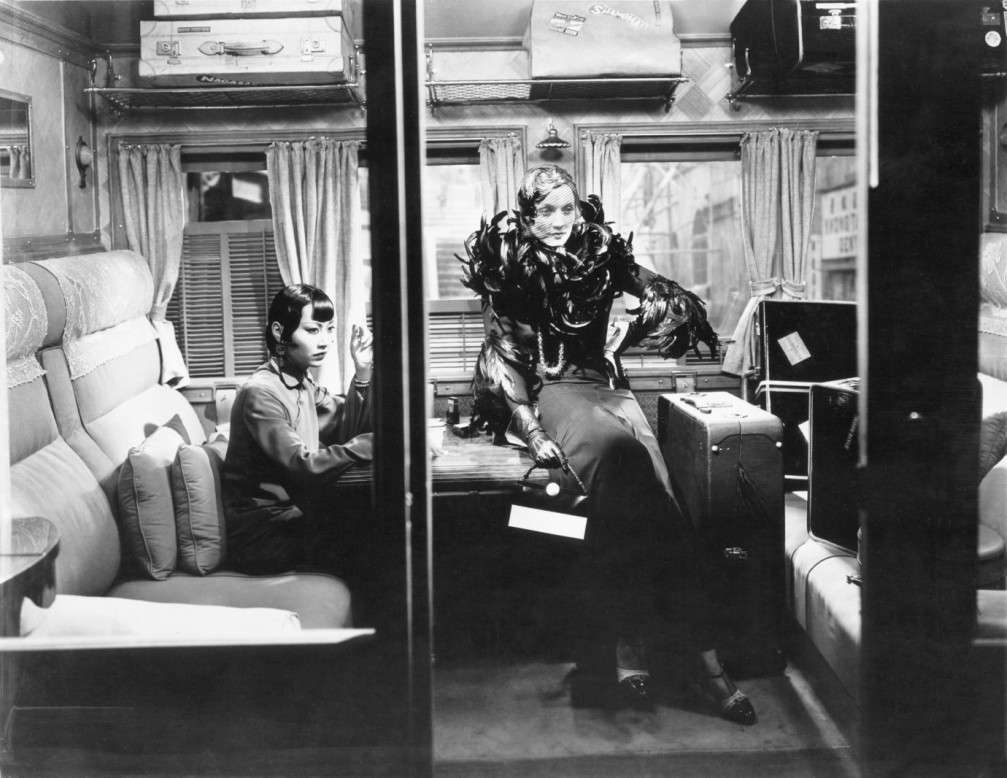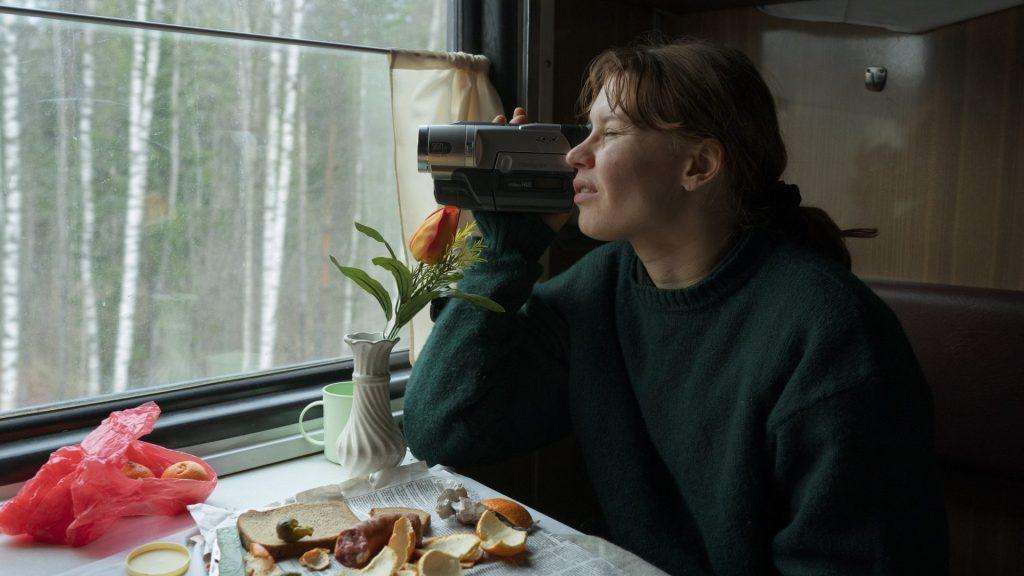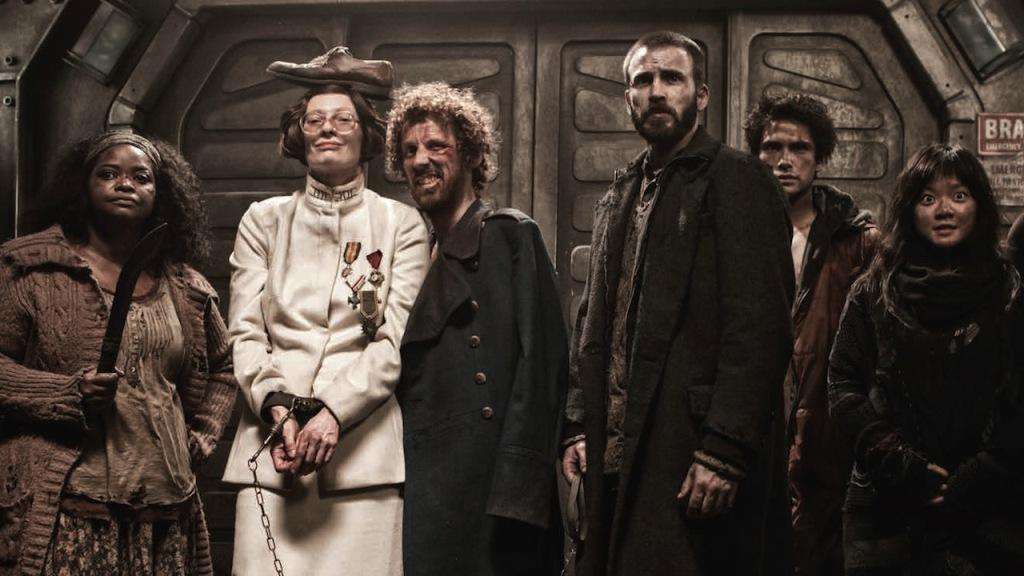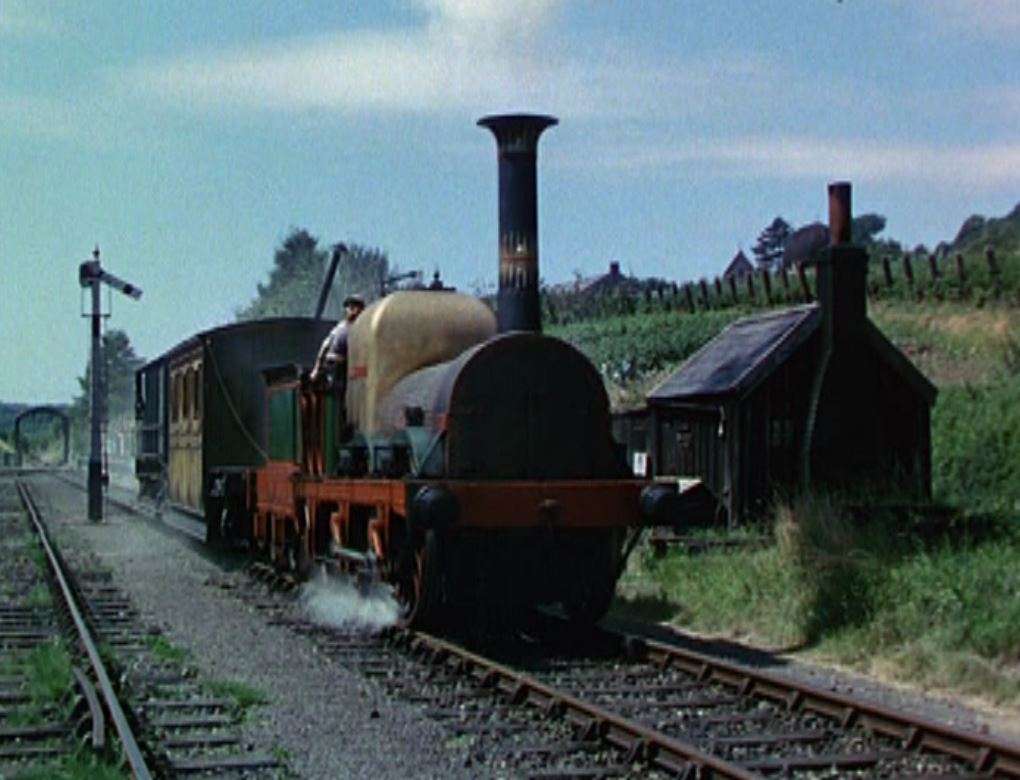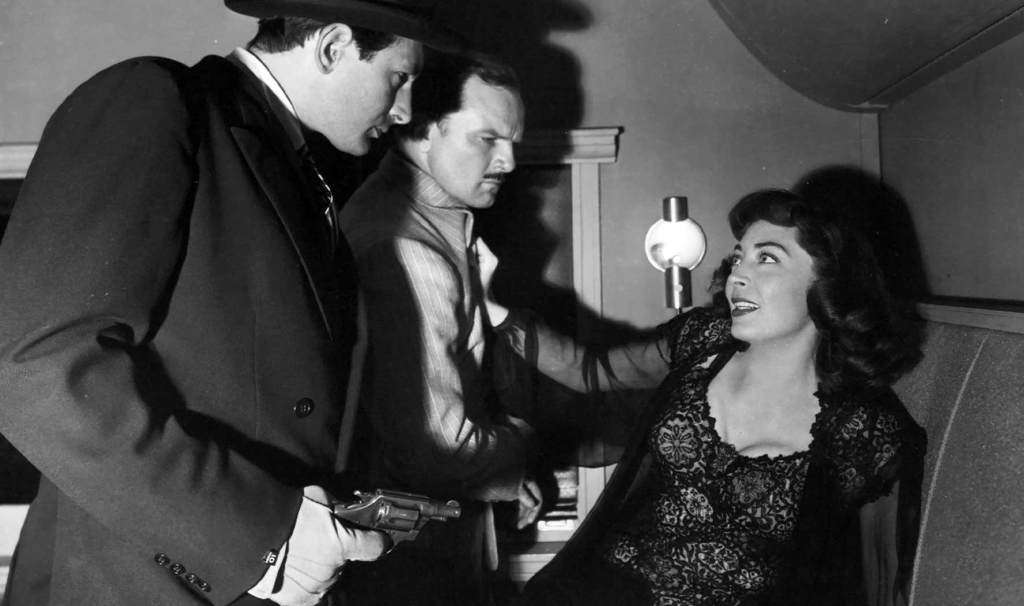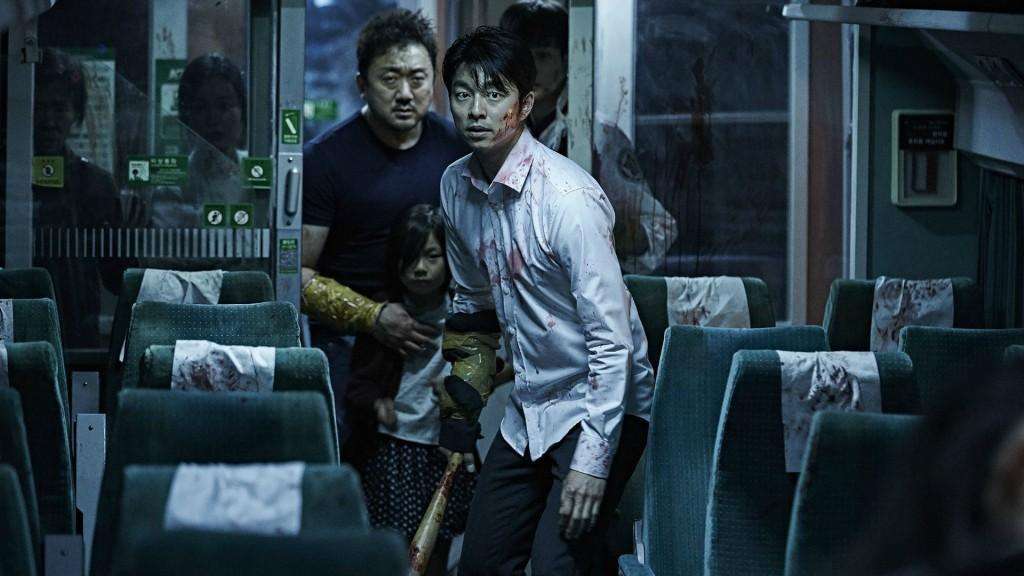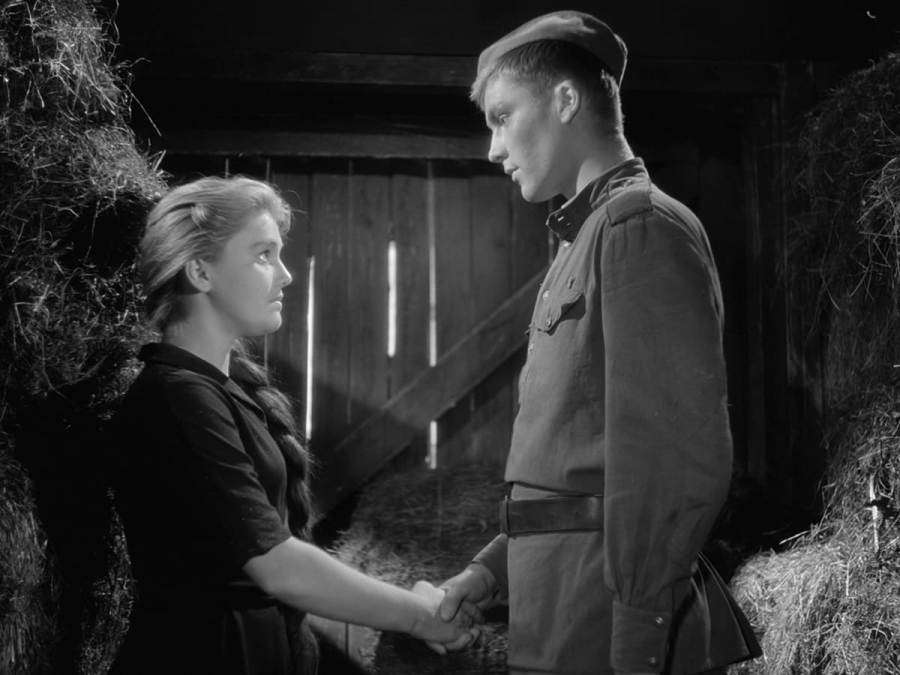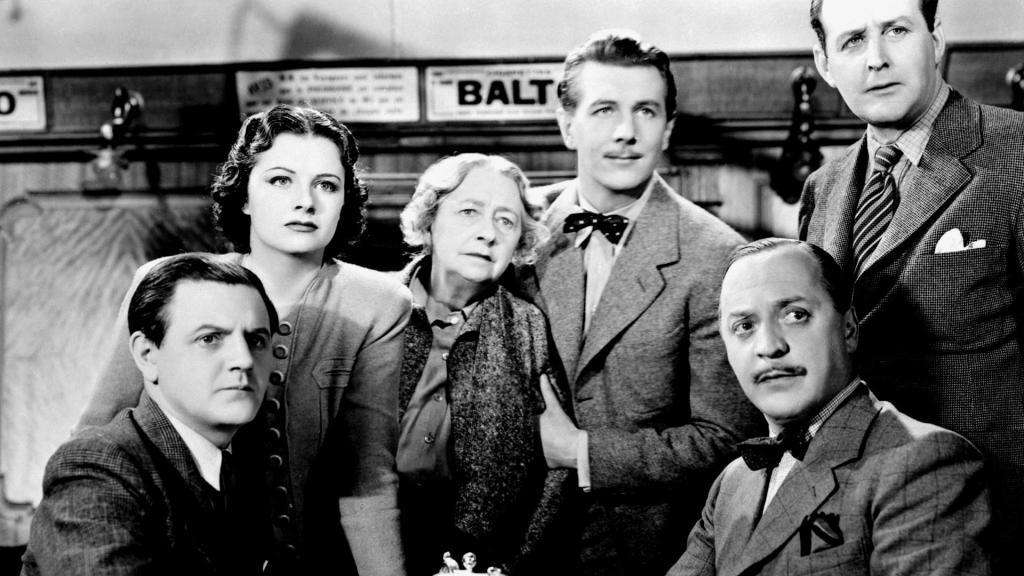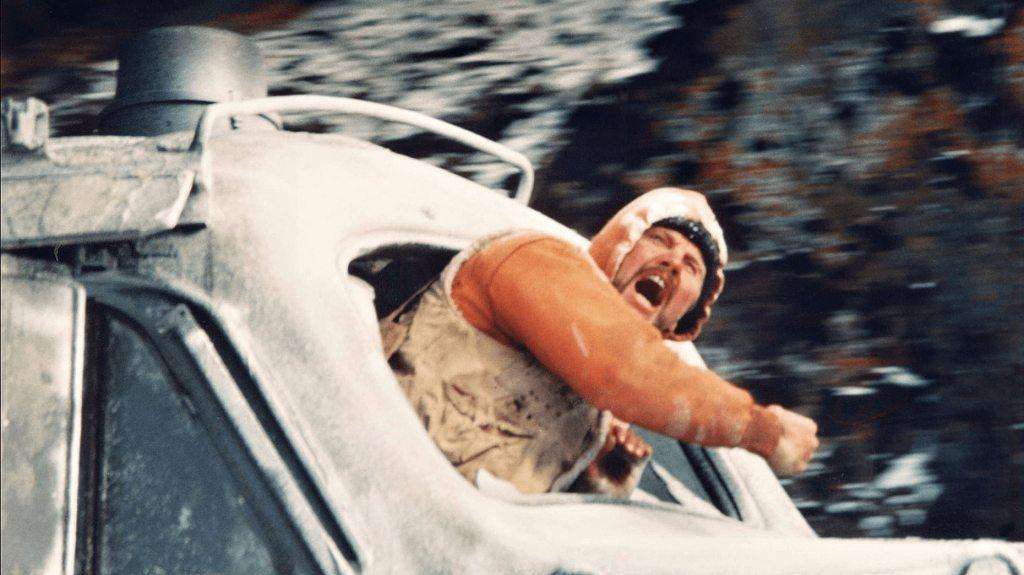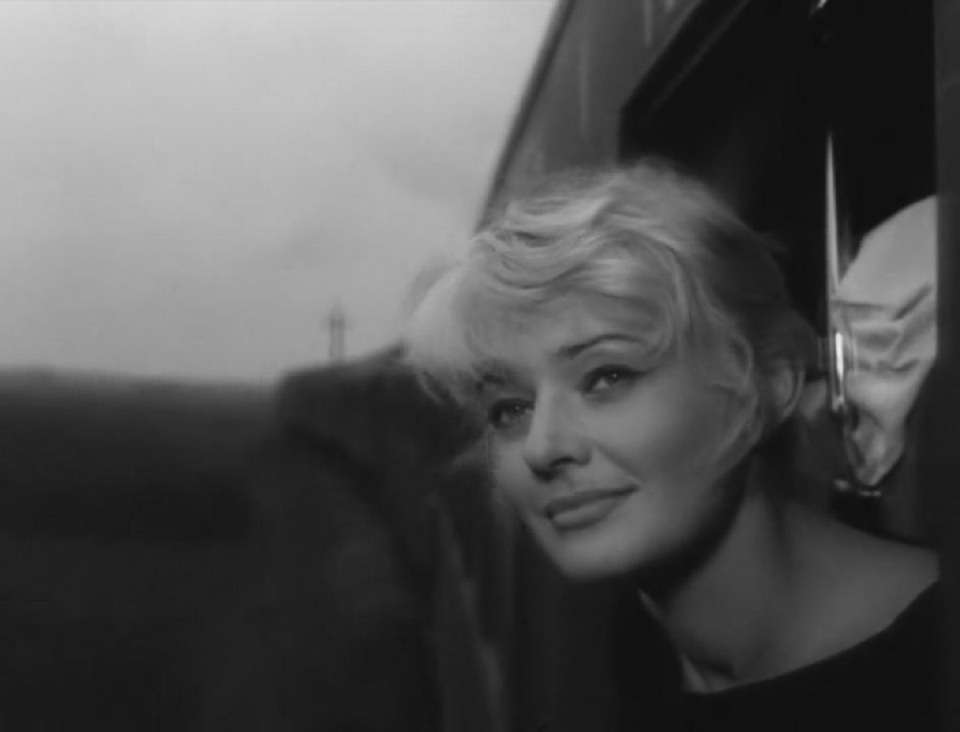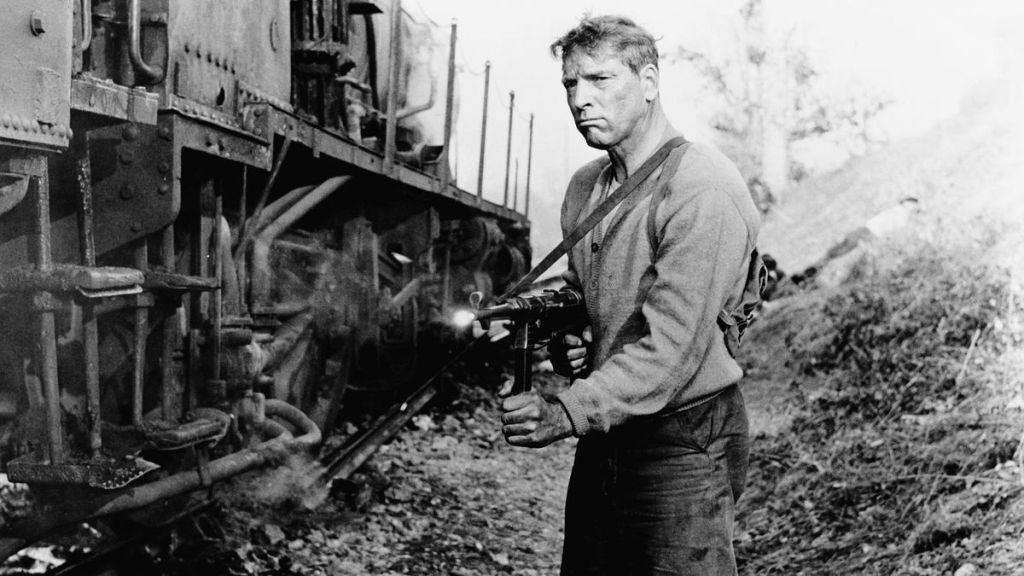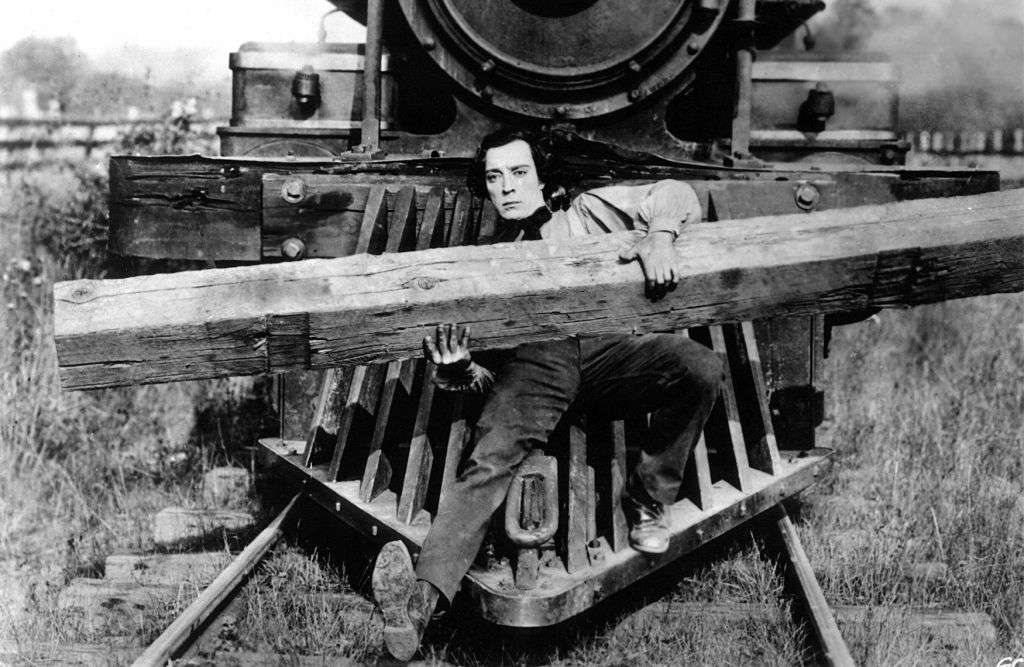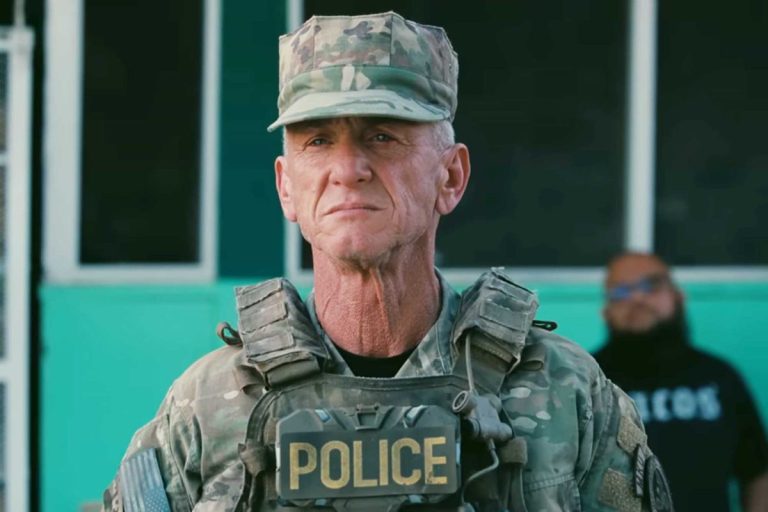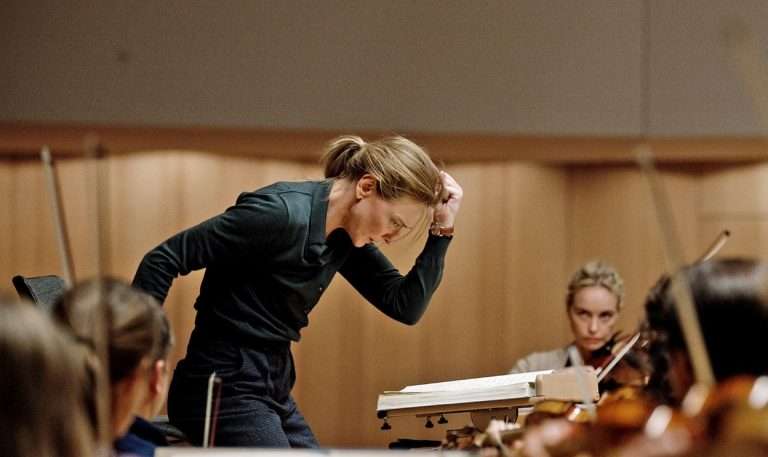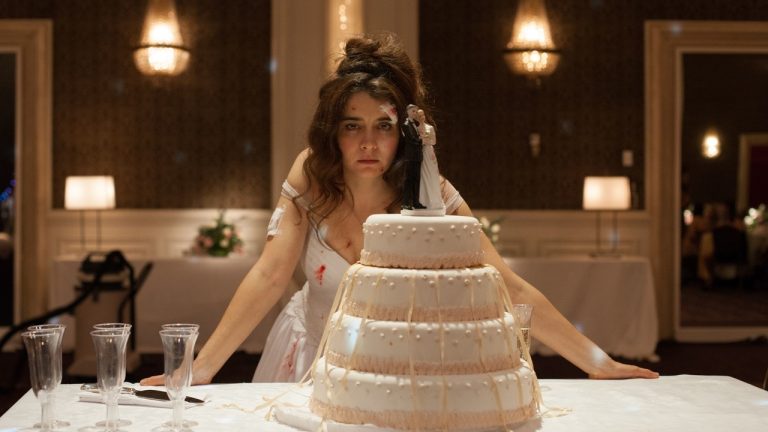Best Train Movies, Ranked: Cinema’s romance with the railways has persisted since the inception of the artistic medium. As the pivotal twin symbols of our modern era, cinema and trains have converged on various occasions. The 1896 audiences’ stupefied reaction to the fifty-second shot of a train chugging towards them (Arrival of a Train at La Ciotat) might be a tall tale of its time, but it’s one of the oft-repeated enchanting foundational myths about cinema. Long before exploring the possibilities in narrative cinema, the artistic medium experimented and evolved by sometimes closely associating itself with trains. The numerous ‘Phantom Ride’ shorts (shot from the front of a moving locomotive), made at the end of the 19th century, conveyed the experience of time and simulated the sensation of travel to the audiences.
An 1899 British short silent film, The Kiss in the Tunnel (by G.A. Smith), marks the small beginnings of narrative editing. In this short, two passengers briefly share a kiss as the train goes into a tunnel. Film scholar Mark Cousins, in his book, “The Story of Film,” called the combination of traveling and interior shots “one of cinema’s first attempts to say, ‘Meanwhile.’” This short was remade and imitated quite a few times, including Edwin S. Porter in the 1903 one-minute short What Happened in the Tunnel. In the same year, Mr. Porter made the 11-minute short The Great Train Robbery. Filled with spectacle and drama, the short shows gang members breaking into a railroad telegraph office to stop a train and rob valuable items from the train.
Porter’s shifting perspectives and formal innovations in The Great Train Robbery proved to be something of a breakthrough in narrative cinema. It also became the archetype of the Western genre. The expressive power of trains permeated cinema in the subsequent decades; from Buster Keaton’s Love Letter to the railroads to the zombie rampage during a high-speed ride, trains’ visual and aural power have been harnessed in different ways by cinema.
Recommended Read: 20 Underrated Road Movies You Need to See
Trains in cinema are ubiquitous. Who can forget the epic assault sequence in David Lean’s Lawrence of Arabia or the precisely rhythmic and tense opening scene at a train depot in Sergio Leone’s Once Upon A Time in the West? The Western genre alone possesses lots of memorable train imagery – 3:10 to Yuma, Butch Cassidy and the Sundance Kid, The Wild Bunch, The Assassination of Jesse James by the Coward Robert Ford, etc. A train ride can drastically change the lives of the movie characters: Strangers on a Train, Blind Chance, and Before Sunrise; the instances are many. Can we imagine Harry Potter without Hogwarts Express? Can we forget the contemplative brilliance of train imagery in Studio Ghibli anime? Watching SRK effortlessly and fabulously dancing on top of a moving mountain train in the iconic ‘Chaiya Chaiya’ song from Mani Ratnam’s Dil Se still gives us a high.
But identifying train movies is a bit tricky. The scope of the list presented here is restricted to feature films that are predominately (or at least a good chunk of its narrative) set in and around a train. Literally and metaphorically, trains play a significant role in these films. I haven’t included railway station-based movies here (Oh, Mr. Porter!, Cairo Station, Closely Watched Trains, Kontroll, etc.), which could be a separate list. Considering the broader spectrum of this category, I would have definitely missed some titles. If so, please mention those in the comments. Now, before you run out of steam and lose your train of thought, let’s get into the list.
Honourable Mentions:
Horror Express (1972)
The Transsiberian Express is the setting for Eugenio Martin’s monster-fossil rampage in Horror Express. It has got a ridiculous Hammer-esque plot and some vapid pseudo-science. But what makes it entertaining is the haunting and inescapable premise of the train and the marvelous casting. English stars Christopher Lee and Peter Cushing are enthralling to watch even though their characters are quite uni-dimensional. They can sell you the most mindless plot developments in a convincing manner. Then there’s Alberto de Mendoza in an enjoyable, over-the-top performance as Father Pujardov. Telly Savalas (The Dirty Dozen) also makes a memorable cameo appearance.
Though made on a very low budget, the interior train sets are adequate enough to cook up the thrills for this wild ride. The exterior visual compositions of the train are mostly miniatures shot in an artful manner, including the effective derailing sequence in the end. Overall, it’s a no-holds-barred horror relic that’s entertaining to an extent.
Silver Streak (1976)
Arthur Hiller’s Silver Streak was a crowd-pleasing entertainer in its days, though its nonsensical suspense story and uneven writing (Colin Higgins) haven’t aged well. Gifted comedian Gene Wilder plays the protagonist George Caldwell, a non-fiction publisher bound for Chicago in the titular express train. He enjoys a bit of romance on the train with the attractive Hilly Burns (Jill Clayburgh), who works as a secretary to the art historian, Professor Schreiner. When George unwittingly becomes a witness to the Professor’s death, he entangles himself in a plot involving a villainous art dealer, Roger Devereau (Patrick McGoohan).
Silver Streak uses the pleasant settings of the train to create a Hitchcockian thriller. While the comedic parts mostly work, the thriller/mystery aspects remain strictly derivative. The runaway train climax weakens an already dull third act. However, the running gag of George getting thrown off the train and making it back is extremely good. More fascinating is George teaming up with the car thief, Grover (a remarkable Richard Pryor). Wilder and Pryor’s comedic partnership makes a big impression on us on this bumpy train ride.
30. Transsiberian (2008)
Brad Anderson’s Hithcockian thriller Transsiberian unfolds in the backdrop of a railroad trip across snow-filled Russian provinces. The narrative follows American couples Roy (Woody Harrelson) and Jesse (Emily Mortimer), who are trying to fix their marital strife by embarking on an adventurous 8-day train journey from Beijing to Moscow. As the title suggests, the trip takes us through the stark landscapes of the Siberian wilderness. On the train, Roy and Jesse come across an attractive, hedonistic young couple, Carlos (Eduardo Noriega) and Abby (Kate Mara). Roy instantly befriends the shady Carlos. As a high-handed Russian narcotics agent, Grinko (Ben Kingsley) boards the train to investigate a drug-related murder, the tense build-up culminates in explosive moments.
Brad Anderson has made some exciting genre films like Session 9 (2001) and The Machinist (2004). In Transsiberian, he brilliantly plays on the fears of meeting mysterious strangers within a confined space. The red-hot sexual tension between Carlos and Jesse brings an intriguing dimension to this frosty ride. Though Transsiberian becomes a typical Hollywood thriller in the final stretches, there’s enough suspense and a magnificent ensemble cast to keep us hooked on this nightmarish journey.
Related to Train Movies: Top 8 Films of Woody Harrelson According to Rotten Tomatoes
29. Bullet Train (2022)
Based on Isako Kotaro’s 2010 novel Maria Beetle, David Leitch’s Bullet Train is a delightful action thriller and black comedy set on a high-speed train traveling from Tokyo to Kyoto. Aboard the train are distinctly characterized assassins on different missions, albeit it somehow feels connected. The convoluted yet fun narrative often teases us about a Keyser Soze-like character known as White Death, a notorious Russian crime lord. It takes some to realize the hyper-active plot machinations. But once every piece in this elaborate, murderous game is assembled, the breakneck pacing is as exhilarating as the train these characters travel.
David Leitch (John Wick, Deadpool 2) is a skillful action filmmaker whose entertainingly exoticized Japanese setup and rousing close-quarters action set pieces succeed in making the ludicrous look pleasurable. The witty dialogues and hyper-kinetic combat are as expeditious as the titular character. Bullet Train does go off the rail in the final half-hour, orchestrating louder destruction and far-fetched twists, but it all works within this context of a wild and warped ride. Overall, it’s a dynamic popcorn flick with a lovely setting and an A-list ensemble cast.
28. Unstoppable (2010)
Tony Scott’s Unstoppable is an enjoyable popcorn flick, unlike the same filmmaker’s remake of Taking of Pelham One Two Three. It features a big and loud thrill train ride, further bolstered by the ever-charismatic presence of Denzel Washington. Washington plays veteran train engineer Frank Barnes, who is paired with a new and young conductor, Will Colson (Chris Pine). Their peaceful run on the Pennsylvania railway network is cut short by the frantic news of a high-speed runaway train carrying toxic chemicals. While the corporate types worry about how the impending disaster will impact the stock prices, Frank and Will initiate an adrenaline-filled plan of action to slow down the train.
Unstoppable, written by Mark Bomback, is too simple and cliched in its characterizations and interactions. But Tony Scott’s hyperactive staging makes it a white-knuckle ride of tension and exhilaration. The high points of this escapist entertainment are the breakneck pace, the believable camaraderie between the two central performers, and the frenetic visualization of the perils of an uncontrollable train. The ‘big curve’ scene is a particularly thrilling moment in the film.
27. Tickets (2005)
The anthology film Tickets brings together three renowned filmmakers – Ermanno Olmi (Italy), Abbas Kiarostami (Iran), and Ken Loach (UK) – to tell three tales set in a trans-European train. Olmi’s first segment follows an old pharmacologist (Carlo Delle Piane) seated in his first-class dining car. His mind wanders during the journey, but he eventually focuses on an Albanian refugee family standing outside the coach’s glass door. Kiarostami’s middle section revolves around a nagging widow of a General (Silvana De Santis) and a young serviceman who is assigned to serve her (Filippo Trojano). Ken Loach’s crowd-pleasing segment follows three blowhard soccer fans who all befriend an Albanian boy.
A train journey is a perfect setting for such synergetic work, where total strangers come together in a chaotic environment. In these tense and heartwarming vignettes, the best and worst of human nature clash, and often, love, altruism, and compassion leave a lasting impact on the journey. All three stories fascinatingly examine 21st-century multicultural Europe with all its class and immigration issues. The three contrasting styles of extraordinarily talented filmmakers tackle such sensitive and meaningful themes in their own unique way.
26. Von Ryan’s Express (1965)
Though not an excellent prisoner-of-war escape drama like Stalag 17 (1953) and The Great Escape (1963), Mark Robson’s Von Ryan’s Express is a tautly plotted action adventure, where a Nazi prison transport train aids the war prisoners’ daring escape. Loosely based on David Westheimer’s novel, the first 40 minutes of the nearly two-hour film establishes the minor conflicts between Frank Sinatra’s Colonel Joseph Ryan and Trevor Howard’s British leader, Major Fincham. But Ryan overcomes his differences and leads his men to take command of the Nazi prison train in an attempt to reach the neutral territory of Switzerland.
Some of the escapees impersonate Nazi officers to pass the German checkpoints. Of course, the deceptions don’t always work. Eventually, there’s a thrilling setpiece of the train moving through the beautiful yet dangerous mountain pass (in the Italian Alps), which culminates with a bittersweet final image. The narrative of an escape Express might not seem very plausible, and the characters are simple archetypes. But Robson’s first-rate filmmaking, scenic background, and the gorgeous sight of steam locomotives draw you into the PoW’s intense adventures.
25. Train of Life (1998)
Roberto Benigni’s Life is Beautiful (1997) mixed certain comedic elements into the solemn backdrop of concentration camps, which garnered its fair share of critique. There’s also the Holocaust drama Jakob the Liar (1999), whose simplistic reaffirmation of humanity was critically panned. Radu Mihaileanu’s Train of Life also skirts around the theme of the Holocaust. But it primarily features a fable-like narrative, which uses the Nazi menace and a whimsical train journey to playfully explore the foibles of the human condition. Set in Central Europe in 1941, a Jewish village, upon hearing the impending arrival of Nazis to deport them, decides to pool their resources to buy a fake deportation train and evacuate themselves across the border. This central conceit is instigated by the village idiot, Shlomo (Lionel Abalanski).
The village’s rabbi (Clement Harari) chooses a handful of men to play the role of Nazi officers while the others are herded into dingy boxcars. Of course, the plan seems too far-fetched to work. Yet once the madcap train ride commences, we understand what the film is getting at. Mihaileanu’s train becomes the microcosm of social and political elements plaguing wartime Europe. Moreover, the fantastical salvation-seeking train ride doesn’t wholly give up the inherently tragic nature of the subject matter. In fact, the shocking final moments push you to recontextualize what you just witnessed.
24. The Darjeeling Limited (2007)
Wes Anderson has often cited Satyajit Ray as a massive influence on his works. His fifth feature film, The Darjeeling Limited, is conceived as a tribute to the legendary Bengali filmmaker and utilizes a prevalent trope in the master’s cinema: train travel. The first half of Anderson’s film is set aboard a train, where three estranged brothers – played by Owen Wilson, Jason Schwartzman, and Adrien Brody – embark on a journey in India to meet their mother living in a convent in the Himalayas. Despite Anderson’s penchant for self-parody and gentle satire, The Darjeeling Limited’s final output does feel like a typical tale of ‘white men seeking spiritual enlightenment in India.’ It definitely provides a breezy viewing experience, but it’s also facile and problematic.
Naturally, the best thing about the film is the titular train, whose interiors are as intricately detailed as any of Wes Anderson’s compositions. The train journey looks like the perfect setup to explore the familiar undercurrents of Anderson’s films: melancholy, jealousy, pettiness, and isolation. Furthermore, the short and loaded exchanges between the brothers, the idiosyncratic camera movements, and Anderson’s signature slo-mo shots feel at home on a train.
Also, Read – All Wes Anderson Movies, Ranked
23. Source Code (2011)
Captain Colter Stevens (Jake Gyllenhaal) wakes up in a Chicago-bound express with no idea of how he got there. His fellow passenger and acquaintance, Christina (Michelle Monaghan), calls him Sean, a history teacher. Stevens doesn’t recognize the man staring back at him in the mirror. But there isn’t much time to worry about his identity since the train explodes into a ball of fire eight minutes after he wakes up. Now, Stevens wakes up in a chamber with the military official Goodwin (Vera Farmiga), briefing him about the unique quantum teleportation method to find the bomber’s identity.
Stevens, under the guise of Sean, has to relive again and again the eight minutes of doomed train travel until he finds the culprit. The passengers can’t be saved. The information is only to avert the impending larger disaster. Director Duncan Jones and writer Ben Ripley deliver sci-fi hijinks to proliferate the thrills. But like in all good sci-fi, the movie’s soul – if we can call it that – doesn’t lie in the geeky stuff but in emphasizing how beautiful and priceless our lives are. Whether it’s Bill Murray’s cynical weatherman or Tom Cruise’s petrified deserter, the puzzling scenarios faced by the protagonists leave us with a life-affirming message. And, it’s all the more good when such ecstatic optimism is intertwined with the social experience of a train travel.
22. The Murder on the Orient Express (1974)
Touted as the only movie adaptation of Agathe Christie’s work, which the author herself was completely satisfied with, the 1974 locked-room mystery has a marvelous ensemble cast and a tour de force performance from Albert Finney as Christie’s eccentric Belgian super-sleuth, Hercule Poirot. Its plot might be well-known to murder-mystery enthusiasts (the 1934 novel has been adapted quite a few for movies and TV, including Kenneth Branagh’s 2017 version). Set in the transcontinental luxury train – traveling from Istanbul to London – in 1935, the shady businessman Ratchett is found murdered in his compartment. Fortunately, Poirot is on board, and as the passengers await for the tracks to be cleared of snowdrift, the detective carries out his investigation.
The thrill of watching Sidney Lumet and screenwriter Paul Dehn’s Murder on the Orient Express doesn’t lie in finding answers to the central mystery but in watching the legendary stars – both young and old – sharing the screen space. And, of course, the majestic steam locomotive remains the most memorable character after Finney’s Poirot. The film was shot by the legendary Oscar-winning cinematographer Geoffrey Unsworth (2001: A Space Odyssey, Tess). Though a large chunk of the narrative unfolds in a stationary train (an extravagant dining car set), Unsworth’s swooning visuals of the fabled train as it departs from the station add to the blissful movie experience.
21. Sin Nombre (2009)
An unprecedented number of migrants embark on dangerous rides on freight trains from Mexico to the US. They travel precariously for nights and days on top of the train to realize their dream of a new life. Cary Fukunaga’s debut feature, Sin Nombre, portrays this bleak social reality with a heart-tugging drama. The narrative revolves around Honduran youths Wily (Edgar Flores), a former gang member, and Sayra (Paula Gaitan), who, with her father, yearns to reach a safe haven in New Jersey. During this perilous passage, as hundreds ride on top of boxcars, Wily and Sayra forge an unexpected alliance.
Sin Nombre is a train ride to the darkest corners of human society, showcasing the extent to which people are driven to seek a life without fear and violence. The title ‘Sin Nombre’ means nameless, which refers to all the persecuted people who are forcefully uprooted from their lands in search of new opportunities. Fukunaga and cinematographer Adriano Goldman filmed aboard actual trains, bringing a vibrancy and emotional intensity to these helpless souls’ exodus from hell. Despite a predictable, straightforward narrative, the unsettling realism of the train ride continually engages us. The Golden Dream (2013) and The Train of Salt and Sugar (2013) also chronicle similar traumatic train journeys.
20. Twentieth Century (1934)
Based on Charles Bruce Milholland’s play, Howard Hawks’ seminal screwball comedy Twentieth Century revolves around a flamboyant Broadway producer, Oscar Jaffe (John Barrymore), and his muse, Lily Garland (Carole Lombard). The first 30 minutes of the narrative chronicles Lily’s rise as a Broadway star under Jaffe’s guidance. Once she becomes a sensation, Jaffe’s pompous, egomaniacal side often registers its presence. Lily leaves New York for Hollywood to escape his possessive behavior. Three years later, the two meet by chance on the luxurious Twentieth Century Express, traveling from Chicago to New York. What follows is the desperate Oscar Jaffe’s hysterically funny shenanigans to make Lily sign a contract for him.
The sneaky pranks of a seemingly innocent old man (Etienne Girardot) add more fun to this theatrical train ride. Though the scenes on the moving train are limited to rear projection and stagey interior sets, the quickfire dialogue delivery works in tandem with the express train set-up. The train journey might be smooth, but screenwriters Ben Hecht and Charles MacArthur concoct ample chaos to fuel the comedic express. Eventually, the explosive performances from Lombard and Barrymore (comprising many delightful dramatic gestures) make Twentieth Century a timeless parody of the creative industries and the people working in it.
19. The Taking of Pelham One Two Three (1974)
Joseph Sargent’s Subway thriller is based on the novel of the same name by Morton Freedgood. The narrative chronicles the tense cat-and-mouse game between Transit Authority Officer Zachary Garber (Walter Matthau) and a smooth-talking criminal, Mr. Blue (Robert Shaw). Mr. Blue and his men hijack a subway car of Manhattan local Pelham 123. They demand a ransom of $1 million and threaten to kill one hostage for every delayed minute.
Taking of Pelham One Two Three is neither the first nor the last subway hostage thriller. There was the heart-wrenchingly devastating independent film The Incident (1967), with ample sociopolitical critique. Moreover, the 1974 film had an underwhelming remake with a stellar cast in 2009. Yet Sargent’s film is more memorable for the intense dramatic action that inventively utilizes narrow spaces and time limits to sustain the thrills. The dramatic efficiency is such that it manages to subtly build the characters without slowing the pace. The other unforgettable element in this nightmarish scenario for commuters is the performances of Matthau and Shaw. Matthau, particularly with his dryly humorous dialogue delivery, dissipates some of the overwhelming tension in the narrative.
Related to Train Movies – 15 Great Psychological Crime Thrillers with Shocking Plot Twists
18. Emperor of the North (1973)
Robert Aldrich, known for Kiss Me Deadly & The Dirty Dozen, made this incredible Depression-era tale, chronicling the battle between a homeless man (Lee Marvin) riding the rails and a sadistic and mean train conductor (Ernest Borgnine). Emperor of the North opens with an infuriating scene as Shack, the tyrannical ruler of Engine 19, wields a steel hammer with murderous intent, causing a hobo to fall under the wheels, his body separated into two pieces. However, the worldly-wise vagrant, A-No.1, manages to sneak into an empty freight car in Engine 19 alongside a loud-mouthed young guy named Cigaret (Keith Carradine). The incident leads to A-No.1 challenging Shack, saying that he will ride Engine 19 all the way to Portland.
Emperor of the North unfolds in a scenic backdrop with some thrilling kinetic set pieces set aboard a moving freight train. The scene where Shack stops the train on a bridge to meticulously search for stowaways possesses great intensity. However, the most memorable train sequence is the climactic showdown between A-No.1 and Shack, which is said to have taken thirty-five days to shoot (according to Borgnine, but Marvin mentioned it took 14 days). The three central characters can come across as stock character types, and we don’t learn much about them in the narrative course. At the same time, Shack and A-No.1 are personifications of Establishment and Anti-Establishment figures, respectively, whereas the railroad remains the key metaphor for life and the world.
17. North West Frontier (1959)
It’s hard to overlook religious stereotyping and white savior storylines in the old and idealized colonial films. J. Lee Thompson’s North West Frontier – based on a script by Frank Nugent – reeks of such problematic and time-worn depictions. This Stagecoach-like narrative (the original story is from John Ford’s son, Patrick Ford) opens with a Muslim rebellion in British India’s North West territory (now in Pakistan). The angry rebels seek to overthrow the Hindu King. While the King is killed, Prince Kishan – a little boy – is saved by the British Captain Scott (Kenneth More) and the Prince’s governess, Catherine (Lauren Bacall).
Captain Scott commandeers an old train with a single carriage to take the boy 300 miles to safety. A few civilian passengers join him, and the journey is palpable with the threat of a rebel attack. The unpleasant subtext aside, there’s plenty to admire in North West Frontier. Foremost is the protagonist, not Capt. Scott; it’s the old locomotive, lovingly called ‘Victoria’ by its Indian engineer, Gupta (I.S. Johar). Some of the railway scenes were shot in Jaipur, where, back then, the meter gauge line was still in use. The hazardous train journey is filled with tremendously edgy moments. I was particularly mesmerized by the damaged bridge crossing sequence.
Lee Thompson and cinematographer Geoffrey Unsworth are the primary reasons why this riveting train adventure thriller works from start to end. Just don’t forget to scoff at the toxic colonial attitudes while enjoying the blissful sight and sound of the rusty engine.
16. The Edge (2010)
Aleksey’s Uchitel’s intense and raw drama, The Edge, is set in Stalin’s prison camp (gulag) in post-war Siberia. The protagonist, Ignat (Vladimir Mashkov), is a concussed and disgraced war hero with a passion for steam locomotives. He is packed off to the remote Siberian gulag, Krai, in September 1945, which consists of political prisoners who were thought to have either collaborated or sympathized with the Germans. The camp has its own social hierarchy, but Ignat doesn’t show much regard for people, and the only thing that interests him is trains.
The Gulag was once a logging camp that facilitated the international collaboration between Germany and Soviet Russia. After a conflict with the camp’s commandant, Ignat goes in search of a locomotive from the old days. He finds it covered in rust and dirt, which is also the home of Elza (Anjorka Strechel), a young German woman. Together, they bring to life the dormant locomotive. The Edge explores one of the little-known chapters in Stalin’s ruthless reign. It balances between gritty realism and colorful cinematic themes. Particularly, Ignat’s romance with the steam engine – Elza calls it ‘Gustav’ – bestows inventive and astounding imagery.
The scenes involving Ignat and Elsa making a jury-rigged bridge to drive their locomotive over the river and the steam locomotive battles are simply dazzling to watch. Moreover, unlike many desolate Russian prison camp dramas, The Edge offers some hope for the characters.
15. The Tall Target (1951)
Anthony Mann, known for his taut, fast-paced Westerns (Winchester ‘73, The Naked Spur), made this edge-of-the-seat noir thriller, set on a train traveling between New York and Baltimore. Loosely based on the alleged ‘Baltimore Plot’ (which claimed that on February 1861, there was a plan to assassinate President-Elect Abraham Lincoln), The Tall Target revolves around New York City Sergeant John Kennedy (Dick Powell). He reports to his superintendent and writes to the War Department about a secret society’s ploy to assassinate Lincoln in Baltimore during his inauguration train ride.
When Kennedy’s suspicions are casually dismissed, the sergeant boards the Night Flyer Express to uncover the conspirators’ identity. During this train ride through pre-Civil War America, Kennedy encounters fascinating characters, including an abolitionist author, an enslaved black maid, and an overbearing Colonel. Apart from the turbulent period setting, the oppressive environment of the train manifests thrilling challenges for Kennedy. The shadowy, paranoia-tinged interiors of the train are integral to the film’s action. Moreover, the perfectly timed station halts provide the breathing space for developing the conspiracy further. The message written on the sooty glass window towards the end leads to a brilliant and unforgettable final scene. Overall, Mann in Tall Target precisely blends noir sensibilities with a unique historical milieu.
Related to Train Movies: 10 Noir Films That Are Under 90 Minutes
14. Shanghai Express (1932)
Josef von Sternberg’s Shanghai Express is a beautifully shot and intriguingly risque pre-code drama. Set in the Chinese Civil War backdrop, the journey aboard the titular express – from Beijing to Shanghai – rekindles an old romance between the scandalous Shanghai Lily (Marlene Dietrich) and Captain Donald Harvey (Clive Brook). It’s a familiar story of love and faith, told through an entertaining set of characters and enchantingly expressionistic cinematography. The fellow passengers in the first-class compartment include a snobbish old British lady, a disgraced French Major, an opium smuggler, a fire and brimstone preacher, a mysterious Eurasian businessman, an American gambler, and an intrepid Chinese woman.
Soon, the rebel troops take control of the train and hold Captain Harvey hostage to demand the release of their spy. The train interior sets are extravagant, although, like many movies of the era, we rarely see any stimulation of a train movement. But Sternberg makes up for it with colorful supporting characters and striking exterior shots of the train. There’s also a funny and exoticized take on the Chinese rail route earlier in the narrative (a stubborn cow halts the locomotive). The organized chaos within an arriving and departing train – in the film’s opening and ending scenes – is another high point for train movie lovers.
Shanghai Express is not a very adventurous train movie, but it is worth celebrating just for the iconic lighting of the transfixing Dietrich’s gaze.
13. Europa (1991)
The poetics of train travel finds a captivating visual expression in Lars von Trier’s black-and-white drama, Europa (aka Zentropa) – the third film in the Danish auteur’s Europe trilogy (comprising The Element of the Crime and Epidemic). Set in the immediate post-war period of October 1945, in Frankfurt, Germany, the film follows an American of German descent, Leopold Kessler (Jean-Marc Barr). Leo, a conscientious objector, seeks the help of his German uncle to find a job in Germany. It’s his way of contributing to the war-torn society (“It’s time someone shows this country a little kindness,” he says). Soon, the idealistic Leo starts working as a sleeping car conductor for the Zentropa railway network.
But Leo’s compassion traps him in circumstances and relationships he can’t control. Though only half of the 112-minute movie is set in the confines of a train, von Trier finds interesting parallels between a train ride and the uncertainties of life, inevitably leading to death. Moreover, the train’s gloomy, tightly framed interiors feel like the microcosm of the disintegrated post-war German society.
The hypnotic voice-over narration (by Max von Sydow) juxtaposed with the visuals of a single light from a train illuminating the rail tracks gracefully guides us into the nightmarish atmosphere. This recurring visual motif reflects the inner journey into Leo’s anxieties, ideals, and fears. Europa, perhaps, has the big emotional or melodramatic love story in von Trier’s oeuvre, which culminates in a tense final half-hour of chaotic train journey.
12. Compartment No.6 (2021)
Juho Kuosmanen’s affecting love story is inspired by Rosa Liksom’s 2011 novel. Do you remember Jesse meeting Celine on a Euro-train in Richard Linklater’s Before Sunrise? Compartment No. 6 doesn’t offer that kind of meet-cute romance. Its protagonist, Laura (Seidi Haarla), an archaeology student, travels from Moscow to Murmansk, Russia’s arctic frontier. She is embarking on this three-day sleeper car train journey to see the petroglyphs. Laura was supposed to take this trip with her professor girlfriend. Her compartment mate is Ljoha (Yuriy Borisov), a miner who gets drunk on the first night and verbally harasses Laura.
Nevertheless, over the course of the journey, despite the rugged exterior appearances of Ljoha, the two form an unlikely bond that’s full of spontaneity and nuanced gestures. Kuosmanen doesn’t show any scenic exterior shots of the train, emphasizing the inner journey of his characters. The darkly lit interiors of the train symbolize Laura’s transition phase (a gray space), who is doing her best to extricate herself from the loneliness bubble. We can easily sympathize with Laura; her anxiety at the early phase of train travel and her impulsive decisions (like getting into a car with Ljoha at one of the longer station halts) are plausible and understandable.
Unlike many American cinematic interpretations of the snowy Russian landscape and its train journeys, Compartment No. 6 incorporates a human touch and an everyday feel to the surroundings. The film is also set in an era (perhaps the 1990s) when people didn’t take refuge behind a mobile screen. Hence, the casual, free-ranging chats between Laura and Ljoha on the train feel more fascinating.
11. Snowpiercer (2013)
In Bong Joon-ho’s adaptation of the French graphic novel Le Transperceneige, a postapocalyptic Noah’s Ark premise delivers a darkly fascinating lesson on the class system or social stratification. A climate change-induced apocalypse has reduced our planet into a frozen wasteland. The last remnants of humanity are ensconced in a perpetually moving, globe-encircling massive train created by the alleged savior of the human race, Wilford (Ed Harris). But the social ecosystem inside the train is strictly governed by a hierarchy that traps the impoverished to the constricted, lower-class tail section, kept in line by gun-toting ruffians. Nevertheless, a disgruntled member of the tail section, Curtis Everett (Chris Evans), with the advice of his mentor, Gilliam (John Hurt), stokes the revolutionary fervor of their people.
Snowpiercer’s train metaphor is as subtle as a sledgehammer. Yet Bong Joon-ho’s remarkable direction bestows an exciting, visceral quality to this never-ending train ride. There are quite a few excellent train action sequences in the film. Some are too far-fetched, but some are absolutely exhilarating, like the face-off between Curtis’ rebels and the masked, machete-wielding Wilford’s men. Another memorable element of Snowpiercer is the spectacular performances from the ensemble cast (kudos to the over-the-top villainy of Tilda Swinton’s Minister Mason).
Related to Train Movies: 30 Best Sci-Fi Movies of the 21st Century
10. The Titfield Thunderbolt (1953)
Like all the precious Ealing Studio comedies about ordinary English people, The Titfield Thunderbolt is an entertaining, meaningful, rose-tinted spectacle. Of course, this Ealing comedy is particularly special because it features the clickety-clack of old trains and the glorious sight of steam locomotives. This hilariously madcap David vs. Goliath story revolves around a group of villagers and train enthusiasts fighting to preserve the local railway line from Titfield to Mallingford. When the British Ministry of Transport closes the line, an unprincipled bus company, Pearce & Crump, tries to monopolize the route. With the help of a local, oft-inebriated philanthropist, the villagers manage to get a one-month probationary period to prove they can run the railway line themselves.
The cunning bus company, naturally, plays a dirty game to sabotage the villagers’ efforts. Eventually, the veteran steam engine, ‘Thunderbolt,’ freed from the local museum, comes to their rescue. The eccentric, distinctly British characters – the cast includes British stars Sid James, Stanley Holloway, and Hugh Griffith – and gorgeous pastoral countryside shots elevate this feel-good heritage preservation story. Titfield Thunderbolt might lack the dark wit and profoundly satirical tone of the best Ealing outputs. Nevertheless, you can’t miss this one if you cherish old trains and tender-hearted fairy tales.
Related to Train Movies: 25 Feel-Good Movies and where to Watch them
9. The Narrow Margin (1952)
Richard Fleischer’s nail-biting noir, The Narrow Margin, admirably uses the confined space of the train for a riveting cat-and-mouse game. This taut and low-budget noir was shot over 13 days in sets, and only a few minutes of the footage were actually shot inside a train. But Fleischer’s extensive use of handheld camera and the top-notch technical & production team brilliantly stimulates the feel of a train’s interiors. Of course, Earl Felton’s script, with its strong moral center and delicious twists, thoroughly immerses us in the events unfolding in an LA-bound train.
The Narrow Margin revolves around LA detective Sgt. Charles Brown (Charles McGraw), who accompanies partner Sgt. Forbes, to protect and bring back a slain mob boss’ wife, Frankie Neall (Marie Windsor), from Chicago to Los Angeles. She is to testify before a grand jury, and a lot of dangerous men don’t want that to happen. When Forbes is killed, it is up to Detective Brown to cleverly maneuver Frankie’s foes and safely present her before the grand jury. The only advantage the detective has is that no one knows how Frankie looks like.
The Narrow Margin is, in many ways, a masterclass in limited-space thriller filmmaking. The movie doesn’t have a musical score and mostly uses a wide mix of train sounds to maintain the tension and thrills of the atmosphere. The 71-minute film also has incredible three-dimensional characters who are neither black nor white.
8. Train to Busan (2016)
A high-speed intercity train and a rapidly spreading zombie outbreak are the deliciously entertaining ingredients of this action thriller. The narrative follows a hard-working, nonchalant, divorced hedge-fund manager, Seok Woo (Yoo Gang), and his sweet little daughter Soo-an (Su-an Kim). They take a train to Busan from Seoul to visit Soo-an’s mother. Just as the train is about to depart, a petrified virus-infected woman boards the train. Soon, the ravenous zombies start multiplying as the train accelerates along a horizontal rail. Amidst this mayhem, few survivors give in to the pressures of upholding the strict vertical system of social stratification. The train can travel at a great speed. But go where? Especially when humanity is infected by a lot more dangerous things than a virus.
Yeon Sang-ho’s Train to Busan doesn’t rely on cheap jump scares, gore, or CGI to amplify the life-threatening situation. Moreover, the constraints of a train compartment and the challenges it brings add to the zombie action and thrills. The film has quite a few crowd-pleasing (Ma Dong-seok’s caring husband character white-knuckling his way through zombified passengers) and fury-inducing (the disgusting wealthy businessman’s willingness to do anything to save his own skin) moments.
Yeon finds inventive ways to sustain the tension. Furthermore, within the high-speed narrative, he provides space for his characters to embark on journeys of self-realization and sacrifice. All in all, a worn-out genre is reinvigorated in this rip-roaring ride.
Related to Train Movies: 15 Great Zombie Movies That You Need To See
7. Ballad of a Solider (1959)
Grigori Chukhrai’s splendidly crafted humanistic WWII drama unfolds from the perspective of a virtuous 19-year-old Russian soldier, Alyosha Skvortsov (Vladimir Ivashov). Pvt. Alyosha commits a heroic deed at the battlefront, for which he receives a decoration, and the General offers him a few days’ leave to visit his mother. Ballad of a Soldier chronicles Alyosha’s arduous and poignant railroad journey to his rural village. There are unplanned detours, and through him, we witness the sufferings and resilience of ordinary Russians.
While stowing away on a military freight train, Alyosha comes across Shura (Zhanna Prokhorenko), an attractive girl who gradually trusts and loves him. But his duties as a soldier don’t allow him to strengthen his romance as we tearfully see them separate at a railway platform. Ballad of a Soldier spends a little over half of its 88-minute narrative in and around trains. The scenery changes, but the trauma of war looms over everyone.
The film opens with the information of Alyosha’s eventual fate. Hence, the soldier’s journey makes us all the more emotional. The camaraderie, compassion, and intimacy Alyosha experiences during the course of the train travel makes us wonder how this young man’s life could have been if not for the war. Sadly, Alyosha will always remain a soldier – not a friend, a lover, or a son.
6. The Lady Vanishes (1938)
Trains are one of the recurrent visual motifs in Alfred Hitchcock’s films. His movies like The 39 Steps (1935), Strangers on a Train (1951), and North by Northwest (1959) establish crucial information or action through train travel. Furthermore, Hitchcock used trains for inventively cheeky cuts (in The 39 Steps and during the ending of North by Northwest). But it’s in his spy comedy/thriller The Lady Vanishes that Hitchcock deftly explores the claustrophobic, paranoia-inducing environment of a train ride. The mechanics of the film are closely intertwined with the movements of the train.
Based on Ethel Lina White’s novel, the film revolves around young, soon-to-be-married Irish Henderson (Margaret Lockwood), who is touring Europe and spending the night at an old Swiss hotel after an avalanche. There, she meets a gregarious old lady, Miss Froy (Dame May Whitty), and an annoying young musician, Gilbert (Michael Redgrave). Miss Froy befriends Iris, and the next day, she gets on the train with her to travel back home. But after a nap, Iris can’t find Miss Froy on the train, and some passengers wonder if there ever was a Miss Froy. Iris takes Gilbert’s help and embarks on a quest inside the train to find the old woman.
The Lady Vanishes has got all the adrenaline-pumping train-bound action set-pieces. In fact, Hitchcock’s remarkable staging here has been imitated multiple times in cinema across the world. The enforced intimacy of the train compartment brings forth camaraderie as well as suspicion.
5. Runaway Train (1985)
“I’m at war with the world and everybody in it,” hollers the escaped convict Manny (Jon Voight) in Andrei Konchalovsky’s Runaway Train, which is a brilliant character study of a man seething with primal instincts. Based on Akira Kurosawa’s screenplay, the film opens at a maximum security prison in Alaska. Manny is out of solitary confinement after three years. Admired as a hero by the prison fellow inmates and dismissed as ‘an animal’ by the tyrannical warden Ranken, Manny can’t be held back either by the laws of humans or nature. He breaks out of the prison with the young and loud-mouthed inmate, Buck (Eric Roberts).
They make it to the railway yard in the subzero temperature and board the locomotive of a freight train. Soon, the uncontrollable Manny meets his perfect match: a speeding, uncrewed train that can’t be stopped by the failsafe mechanisms in place. Despite a very dramatic setup, Runaway Train is an astounding thriller with profound existential themes. The out-of-control locomotives offer much more than adrenaline-pumping sequences. The untameable train feels like a symbol of our mad world, and the three individuals trapped in it, clashing over their beliefs, represent humanity at its most good and worst. Director Konchalovsky himself said, “The train is a symbol for whatever you want it to be.”
Runaway Train is full of terrific atmosphere and indelible imagery. I especially love the final visual of Manny standing atop a lone, speeding locomotive – one man against the world.
Related to Train Movies – List of 100 Best Movies by Japanese Filmmaker Akira Kurosawa
4. Night Train (1959)
Jerzy Kawalerowicz’s Night Train (Pociag) offers one of the perfect visual renditions of a train journey in cinema. We get into the train that’s traveling overnight from Lodz to the coastal city of Hel, and we practice concealed voyeurism like our fellow passengers, trying to get a grip on the various conflicts impacting the multiple characters. Alas, we reach our destination, forgoing the connections we made with some, and reflect on the resentment we hold for others as we part ways, staring off toward the horizon – we and those empty compartments keep moving in search of new destinations, just like life.
Under the guise of a mystery/thriller, Night Train profoundly studies human sensibilities. The train remains a microcosm of human society with all its good, mad, and wicked qualities. The narrative primarily follows an enigmatic and agitated man, Jerzy (Leon Niemczyk), and the indignant Marta (Lucyna Winnicka). They both want to be alone but end up being the bunkmates in the first-class compartment. The central characters’ complicated inner conflicts define their experiences in the journey. The mystery element and the gossiping, leering, and flirtatious passengers bestow a Hitchcockian vibe to the narrative.
Earlier in the narrative, the passengers speak of a murderer who has killed his wife. This mysterious man is later said to be on the train, and the pursuit of him leads to the only high dramatic event in the trip. Jerzy Kawalerowicz cleverly uses this ‘killer’ subplot to showcase the less savory aspects of human behavior. It might be hard to comprehend the social context of the era it was set in (post-war Poland). At the same, Night Train has enough universal elements to capture the intriguing emotional curve of train travel.
3. Nayak (1966)
Trains are one of the recurring visual motifs in Satyajit Ray’s oeuvre. The symbolism of railways and train journeys has its own intriguing arc in Ray’s Apu Trilogy. In Sonar Kella – based on Ray’s Feluda series – the train transport provides insights about the characters and facilitates the riveting intersection of journeys. But if you are looking for a sustained train experience in the master’s works, one must turn to the meticulously crafted drama Nayak (The Hero). The film closely examines the loneliness of a matinee idol as he embarks on a long train trip from Kolkata to Delhi.
The titular character, Arindam Mukherjee, is played by a remarkably subdued Uttam Kumar, who is making the physical journey to collect a prestigious award. Once the journey begins, we are introduced to a collection of characters in the first-class compartments and dining car, representing a microcosm of India’s moneyed and intellectual class. The smug movie star’s emotional journey is set in motion as he interacts with various people who are either star-struck or withhold mild resentment. The character portrait of Arindam gets increasingly fascinating through his conversations with Aditi (Sharmila Tagore), a patient listener who eventually understands and sympathizes with the individual lying beneath Arindam’s carefully cultivated star persona.
Read More – 100 Years of Mrinal Sen: Remembering the Icon of Indian Political Cinema
The confinements of the train compartment and the exchanges it provokes play a vital role in building the complexities of Arindam and the world around him. It’s a journey of unraveling and coming to terms with one’s own self without offering any neat resolution to the inner turmoil. Moreover, Nayak’s colorful secondary characters – from the smiling silent girl, Bulbul, to the disapproving senior journalist & critic, Aghore – are so engaging. Though the film is primarily set inside the first-class coaches, Ray brilliantly employs eclectic cinematic styles to amplify the drama – the most memorable among them is the startling dream sequence.
2. The Train (1964)
John Frankenheimer’s masterpiece belongs to the category of “They don’t make movies like that anymore!” These are the sweeping epics with incredible action set-pieces, technical brilliance (sans CGI), and remarkable character writing. Set in 1944 France, during the last days of Nazi occupation, The Train is centered around a valuable art train, comprising the treasure of France, which the German Colonel von Waldheim (Paul Scofield) wants to transport to Berlin. Our protagonist is Burt Lancaster’s Paul Labiche, a French railroad engineer and Resistance Fighter, who, with the help of several railroad workers, crafts an elaborate deceptive plan to sabotage the Colonel’s efforts without blowing up the train. They need to save the train from the occupiers until the impending arrival of Allied Forces.
The grand scale of train-focused action makes Frankenheimer’s film as priceless as the art train. A fast-moving locomotive crashing into a derailed engine, the edge-of-the-seat stunt of uncoupling an engine, the breathtaking sequence of air raids on railway yards, the march of armored locomotives, the splendor of crane tank engines – the film contains plenty of rousing moments for train enthusiasts. The crash sequence (shot using seven cameras and only a single take was possible) is the single most extraordinary on-screen train sequence after the river-gorge crash sequence in Buster Keaton’s The General (1927).
The script has a few pretentious and convoluted aspects, but the multi-layered moral dilemmas and the sheer conviction with which Frankenheimer has staged the action set-pieces easily win you over. The intensity and charisma of Burt Lancaster, alongside the marvelous performances of Scofield, Michel Simon, Albert Remy, and Jeanne Moreau, add more intrigue to this kinetic train action flick. Overall, Frankenheimer’s The Train is one of the most groundbreaking action films in cinematic history.
Related to Train Movies: 10 Best Action Sequences from the Mission Impossible Franchise
1. The General (1927)
Set in the American Civil War era, Buster Keaton’s ‘stone-faced’ protagonist is a young Confederate railroad engineer who loses his beloved locomotive and sweetheart, Annabelle, to the Union spies. He commandeers another engine, goes deep into the enemy territory, achieves his mission, and unwittingly becomes a hero. The General is a typical Keaton vehicle, which gradually intensifies the madcap nature of his complicated gags. Keaton’s deadpan visage perfectly contrasts his kinetic energy, which particularly astounds us when he pulls dangerous stunts involving automobiles.
Buster Keaton is a train lover, and before The General, he magnificently staged elaborate set pieces around train travel in the 1923 film Our Hospitality. He used a 19th-century steam locomotive in this film known as Stephenson’s Rocket. Running on bumpy, flexible tracks, the engine pulls a bunch of stagecoach carriages. A family feud fuels a string of gags in this rudimentary train journey. With The General, Keaton’s imagination grew bigger and more daring. The motion on screen is so kinetic and relentless, from pulling railroad ties in the tracks to uncoupling boxcars. Yet Keaton visualizes each chaotic moment with unparalleled elegance and preciseness. The awe-inspiring Rock River bridge collapse sequence (at the end of The General) still stands tall amidst the several CGI climactic train wrecks.
You might have heard of the irresistible force paradox (what happens when an unstoppable force meets an immovable object?). At least, in cinema, we can say that the answer to it is a masterwork like The General – the undoubtedly fantastic train movie of all time.
Also, Read: 10 Best Soviet Silent Comedy Films



